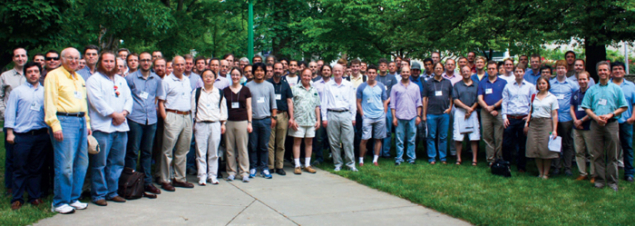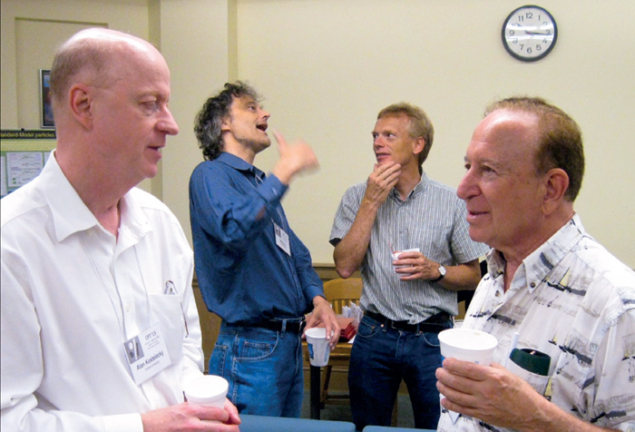A meeting in Indiana reviewed tests of Lorentz and CPT symmetries.

Image credit: Jorge S Diaz.
Albert Einstein’s theory of relativity is one of the most successfully tested ideas in physics. Based on the statement that the laws of physics are invariant under rotations and boosts – officially known as Lorentz symmetry – relativity is a cornerstone of the two most successful descriptions of nature: general relativity and the Standard Model. Although experiments to date indicate that relativity provides an accurate description, it became clear in the late 1980s that violations in relativity could appear theoretically as natural features of candidate models of quantum gravity.
During the following decade, a group of theorists led by Alan Kostelecký at Indiana University developed a general framework extending general relativity and the Standard Model to include all possible violations of Lorentz symmetry and CPT symmetry – the combination of charge conjugation, C, parity inversion, P, and time reversal, T – in a realistic field theory. This framework, called the Standard-Model Extension (SME), provides practical methods to compute observable effects for a given experiment. As a result, its advent triggered wide-ranging interest in the features of relativity violations.
Over the past 15 years or so, the experimental community has also enlisted in this challenging enterprise and the search for Lorentz violation has now turned theoretical ideas into a formal field in which theorists and experimentalists worldwide explore possible signals that could reveal that relativity is not exact. Despite the fact that current technology is far from reaching energies that are relevant for quantum gravity, the SME has shown that it is possible to probe well beyond the Planck scale by searching for suppressed effects in low-energy experiments.
In June, the 6th Meeting on CPT and Lorentz Symmetry (CPT’13) took place in Bloomington, Indiana. The latest in a series of unusual conferences that are held every three years, it brought together physicists from a variety of disciplines and global locations to discuss new results and future prospects for studying these fundamental spacetime symmetries. The experiments testing CPT and Lorentz symmetry and the theoretical calculations presented at the meeting together span an impressive set of subfields in physics. Furthermore, the techniques involved cover energies from fractions of an electron-volt to millions of giga-electron-volts.
Given the deep connection between Lorentz invariance and the CPT theorem in local field theory, one of the direct tests of these symmetries involves comparisons between the behaviour of matter and antimatter systems. The ALPHA collaboration reported on the remarkable progress made along these lines in its experiment at CERN. The collaboration has used antihydrogen traps to store antiatoms for several minutes and to perform basic spectroscopy (CERN Courier July/August 2011 p6). These long timescales for antiatomic systems also offer interesting prospects for studying the effects of gravitational fields.
An important theoretical development in the SME described at the meeting is the study of the effects of relativity violations in couplings of gravity to matter and antimatter. This work has motivated different tests of the equivalence principle as presented by several groups including those at the Max Planck Institute for Nuclear Physics in Heidelberg, the University of California at Berkeley and the University of Pisa. Results of analyses using data from the Gravity Probe B satellite were also presented at the meeting.
Particle physics offers another experimental playground to test Lorentz and CPT invariance. The manner in which Lorentz violation could appear in different systems includes modifications to the kinematics arising from unconventional energy–momentum relations as well as dynamic effects in interactions between different particles. A basic notion in the SME is that breaking Lorentz symmetry must lead the universe to manifest at least one preferred direction. For this reason, one of the key signals to study in Earth-based experiments is the sidereal variation of the relevant experimental observables resulting from the change in the coupling between the system studied and the preferred direction in the universe.

Image credit: Neil Russell.
Sidereal variations are one of the most used techniques for testing Lorentz symmetry. At the meeting, the experimental group at the University of Groningen presented its implementation of such a test in which the researchers search for sidereal variations in the β-decay rate of sodium atoms. Following a similar approach, a recent proposal formulates the effects of Lorentz violation in the β decay of tritium. The experimental group at the University of Washington reported on the status of the KATRIN experiment and reviewed the use of this detector, which is designed for direct measurement of the mass of the neutrino, as a probe of Lorentz and CPT symmetry using tritium decay. Signals to be tested include the sidereal variation of the endpoint energy and other effects that could mimic a nonzero neutrino mass.
The free propagation of neutrinos has also served as a sensitive probe of Lorentz symmetry. The Double Chooz experiment is designed to measure θ13 – the last of the three neutrino-mixing angles, which is responsible for the disappearance of reactor antineutrinos and is key in the possibility of CP violation in neutrinos. Using data from this experiment, a team from Massachusetts Institute of Technology has recently performed a search for sidereal variations of antineutrino oscillations in the context of the SME and also explored the effects of Lorentz violation in the form of possible neutrino–antineutrino oscillations. Other interferometric techniques reported at CPT’13 included sidereal studies performed using the semileptonic decay of B mesons in the DØ experiment at Fermilab and neutral kaons in the KLOE experiment at INFN’s Frascati National Laboratory. No compelling evidence of Lorentz violation has appeared but impressive new limits on SME coefficients that control deviations from exact symmetry have been established.
In the past, most studies of Lorentz violation have used the minimal SME as a theoretical framework. The minimal SME extends the Standard Model by incorporating only operators of mass dimension four or less, which guarantee power-counting renormalizability of the theory. One of the most ambitious goals in recent years has been the explicit identification and classification of SME operators of arbitrary mass dimension. The basics of the theory of these so-called non-minimal terms were presented in the photon sector in the previous meeting in this series – CPT’10 (CERN Courier October 2010 p29). In the intervening three years, several experimental searches have demonstrated the advantage of studying high-energy photons from astrophysical sources and the competitive sensitivity of different tabletop experiments.
Using astrophysical observations of sources of X and γ rays at cosmological distances, researchers from Washington University in St Louis reported on a systematic study of non-minimal operators in electrodynamics and provided new limits on photon SME coefficients. Using data from the HESS, MAGIC and VERITAS telescopes, the study searched for the possible energy dependence of the speed of high-energy photons. This is one of the unconventional effects predicted by the SME as a consequence of modified photon dispersion relations. The team now plans to use polarimetry measurements with future space telescopes to explore other effects predicted by the SME.
Despite the great sensitivity of high-energy photons, some Lorentz-violating effects are undetectable in astrophysical measurements. In this case, resonant cavities act as complementary probes of quantum-gravity effects. Microwave cavities and cryogenic sapphire oscillators have allowed scientists at the University of Western Australia to complete the first laboratory study of non-renormalizable operators in the SME. In Berlin, cryogenic optical resonators and systems of ultracold atomic quantum gases have been developed by researchers at Humboldt University as tools to test relativity, both on Earth and in space.
The remarkable number of experimental studies already performed has led to a vast number of experimental constraints on SME coefficients that control the various ways that Lorenz symmetry can be broken in different sectors of the theory. The results are compiled in a rapidly growing document – Data Tables for Lorentz and CPT Violation – which is updated every year. Nonetheless, many more effects remain unexplored. The CPT’13 meeting provided a welcome week-long opportunity to exchange ideas, initiate collaborations and share experimental and theoretical techniques among different sectors. The study of violations of Lorentz and CPT symmetry is a continuing and exciting adventure with many new directions still to be explored.







